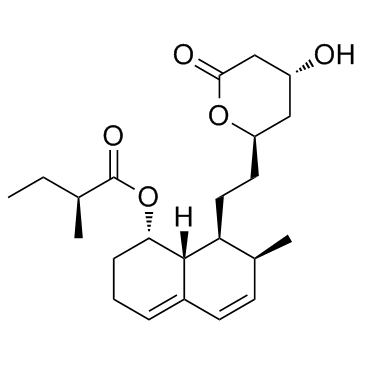Mevastatin

Mevastatin structure
|
Common Name | Mevastatin | ||
|---|---|---|---|---|
| CAS Number | 73573-88-3 | Molecular Weight | 390.513 | |
| Density | 1.1±0.1 g/cm3 | Boiling Point | 555.0±50.0 °C at 760 mmHg | |
| Molecular Formula | C23H34O5 | Melting Point | 151-153 °C | |
| MSDS | Chinese USA | Flash Point | 186.5±23.6 °C | |
|
Endothelial protective genes induced by statin are mimicked by ERK5 activation as triggered by a drug combination of FTI-277 and GGTI-298.
Biochim. Biophys. Acta 1850 , 1415-25, (2015) Statins are potent inhibitors of cholesterol biosynthesis and are clinically beneficial in preventing cardiovascular diseases, however, the therapeutic utility of these drugs is limited by myotoxicity. Here, we explored the mechanism of statin-mediated activa... |
|
|
Chemical genetics reveals a complex functional ground state of neural stem cells.
Nat. Chem. Biol. 3(5) , 268-273, (2007) The identification of self-renewing and multipotent neural stem cells (NSCs) in the mammalian brain holds promise for the treatment of neurological diseases and has yielded new insight into brain cancer. However, the complete repertoire of signaling pathways ... |
|
|
Chemical profiling and quantification of monacolins and citrinin in red yeast rice commercial raw materials and dietary supplements using liquid chromatography-accurate QToF mass spectrometry: Chemometrics application.
J. Pharm. Biomed. Anal. 100 , 243-53, (2014) Red yeast rice (RYR) is prepared by fermenting rice with various strains of the yeast Monascus spp of the Aspergillaceae family. Depending on the Monascus strains and the fermentation conditions, the products may contain monacolins, pigments and citrinin as s... |
|
|
In vitro and in vivo anticancer effects of mevalonate pathway modulation on human cancer cells.
Br. J. Cancer 111(8) , 1562-71, (2014) The increasing usage of statins (the 3-hydroxy-3-methylglutaryl-coenzyme A reductase inhibitors) has revealed a number of unexpected beneficial effects, including a reduction in cancer risk.We investigated the direct anticancer effects of different statins ap... |
|
|
2-(3-Benzoylthioureido)-4,5,6,7-tetrahydrobenzo[b]thiophene-3-carboxylic acid ameliorates metabolic disorders in high-fat diet-fed mice.
Acta Pharmacol. Sin. 36(4) , 483-96, (2015) Sterol-regulatory element binding proteins (SREBPs) are major transcription factors that regulate liver lipid biosynthesis. In this article we reported a novel synthetic compound 2-(3-benzoylthioureido)-4,5,6,7-tetrahydrobenzo[b]thiophene-3-carboxylic acid (Z... |
|
|
Differential roles of the mevalonate pathway in the development and survival of mouse Purkinje cells in culture.
Mol. Neurobiol. 51 , 1116-29, (2015) The cerebellum is an important locus for motor learning and higher cognitive functions, and Purkinje cells constitute a key component of its circuit. Biochemically, significant turnover of cholesterol occurs in Purkinje cells, causing the activation of the me... |
|
|
Identifying off-target effects and hidden phenotypes of drugs in human cells.
Nat. Chem. Biol. 2 , 329-37, (2006) We present a strategy for identifying off-target effects and hidden phenotypes of drugs by directly probing biochemical pathways that underlie therapeutic or toxic mechanisms in intact, living cells. High-content protein-fragment complementation assays (PCAs)... |
|
|
A highly efficient three-phase single drop microextraction technique for sample preconcentration.
Analyst 140(9) , 3193-200, (2015) A highly efficient three-phase single drop microextraction (SDME) method is presented by using an organic-aqueous compound droplet. A coupling microdevice is designed to produce compound droplets in different sizes conveniently. In this way, the volume ratio ... |
|
|
Media formulation influences chemical effects on neuronal growth and morphology.
In Vitro Cell. Dev. Biol. Anim. 51 , 612-29, (2015) Screening for developmental neurotoxicity using in vitro, cell-based systems has been proposed as an efficient alternative to performing in vivo studies. One tool currently used for developmental neurotoxicity screening is automated high-content imaging of ne... |
|
|
A dimer is the minimal proton-conducting unit of the influenza a virus M2 channel.
J. Mol. Biol. 426(14) , 2679-91, (2014) When influenza A virus infects host cells, its integral matrix protein M2 forms a proton-selective channel in the viral envelope. Although X-ray crystallography and NMR studies using fragment peptides have suggested that M2 stably forms a tetrameric channel i... |